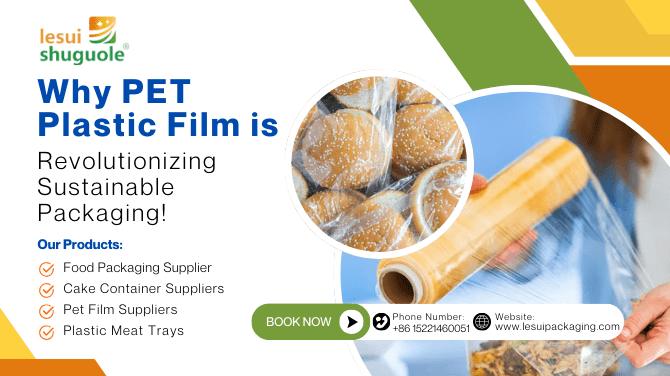
For businesses and consumers alike, sustainability is no longer an option—it’s a necessity. With global efforts to reduce waste and carbon footprints, industries are constantly searching for materials that offer both functionality and environmental benefits. One material leading the charge is PET plastic film. Known for its recyclability, durability, and versatility, PET plastic film is transforming the way companies approach sustainable packaging.
Understanding PET Plastic Film
What is PET Plastic Film?
PET (Polyethylene Terephthalate) plastic film is a lightweight, transparent, and durable material widely used in the packaging industry. It is made from thermoplastic polymer resin and is known for its high strength, flexibility, and clarity.
How is PET Plastic Film Made?
The production process of PET plastic film involves the polymerization of ethylene glycol and terephthalic acid. The resulting material is then extruded into thin sheets or films that can be used for a variety of applications. Advanced manufacturing techniques also allow for the creation of multi-layered PET films with enhanced properties.
Key Properties of PET Plastic Film
- Recyclable: PET plastic film can be recycled multiple times without losing its quality.
- Durable: It offers excellent resistance to tearing and punctures.
- Lightweight: Helps reduce transportation costs and carbon emissions.
- Barrier Protection: Provides a strong barrier against moisture, oxygen, and contaminants.
- Customizable: Can be printed, laminated, and shaped to fit various packaging needs.
The Sustainability Factor of PET Plastic Film
Is PET Plastic Film Recyclable?
Yes! One of the biggest advantages of PET plastic film is its recyclability. Unlike many other plastic materials, PET can be collected, processed, and reused in new packaging products multiple times, reducing landfill waste.
Comparing PET Plastic Film to Other Packaging Materials
Compared to traditional packaging materials like PVC, polyethylene, and aluminum foil, PET plastic film stands out due to its eco-friendliness, cost-efficiency, and durability. While glass and metal are also recyclable, they are much heavier, leading to higher transportation emissions.
How Does PET Plastic Film Reduce Waste?
- Reduces reliance on single-use plastics
- Encourages a circular economy through recycling
- Helps manufacturers cut down on material costs by using thinner, stronger films
Applications of PET Plastic Film in Packaging
- Food and Beverage Industry
PET plastic film is commonly used for bottle labeling, flexible pouches, and vacuum-sealed food wraps. It ensures product freshness while offering a clear, glossy appearance for branding. - Pharmaceutical and Medical Packaging
The pharmaceutical industry relies on PET plastic film for blister packs, sterile wraps, and protective coverings to keep medicines safe and contamination-free. - Electronics and Industrial Uses
In the electronics sector, PET plastic film is used for protective coatings, insulation layers, and display screens due to its high temperature resistance and durability.
Advantages of PET Plastic Film for Businesses
- Cost-Effectiveness
Businesses save on manufacturing, shipping, and storage costs thanks to the lightweight nature of PET plastic film. - Lightweight and Durable
Its lightweight composition helps lower transportation emissions, making it an environmentally and economically sound choice. - Customization and Branding Opportunities
PET plastic film can be printed, embossed, or laminated, offering businesses creative ways to showcase their brand.
The Future of Sustainable Packaging with PET Plastic Film
- Innovations in PET Plastic Film Technology
Ongoing research is leading to biodegradable PET alternatives and improved recycling methods. - Government Regulations and Sustainability Initiatives
Many countries are introducing plastic waste reduction policies that encourage the use of recyclable materials like PET plastic film. - Consumer Preferences and Market Trends
Eco-conscious consumers are driving demand for sustainable packaging solutions, pushing businesses to adopt PET plastic film.
Challenges and Considerations
- Potential Drawbacks of PET Plastic Film
- Requires proper waste management and recycling infrastructure
- Can be costly for companies transitioning from traditional plastics
- Addressing Recycling and Waste Management Issues
- Governments and businesses must invest in better recycling facilities
- Consumers should be educated on proper disposal practices
As the demand for sustainable packaging grows, PET plastic film is proving to be a revolutionary solution. With its recyclability, durability, and cost-effectiveness, it is paving the way for a more environmentally friendly future. Businesses across industries are recognizing its potential, making PET plastic film a key player in the move toward sustainable packaging.
FAQs
1. Is PET plastic film biodegradable?
No, PET plastic film is not biodegradable but is highly recyclable, reducing waste in landfills.
2. How many times can PET plastic film be recycled?
PET plastic film can be recycled multiple times without losing its quality.
3. What industries benefit the most from PET plastic film?
Industries such as food and beverage, pharmaceuticals, electronics, and retail packaging benefit the most from PET plastic film.
4. Is PET plastic film safe for food packaging?
Yes! PET plastic film is FDA-approved for food contact and is widely used in food packaging.
5. How does PET plastic film compare to other sustainable packaging options?
Compared to alternatives like biodegradable plastics and glass, PET plastic film offers a balance of recyclability, cost-effectiveness, and durability.
